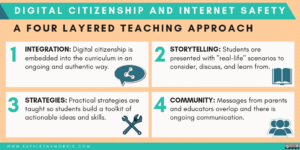As we move forward in the Digital Age with our students, is it our job teach our students about Digital Footprint? Technology has become such a large part of education and in the lives of the kids we work with daily. As a classroom teacher, I feel that this is something that we can’t pass on. I have been teaching grade 5 for the past 9 years the number of students in my class who now have phones has increased incredibly. When I first started teaching my current grade I would say that maybe a handful of students had their own personal device. Fast forward 9 years later, I would say that only handful of my students do not have their own device! I have had numerous conversations with my students about what we see online, the importance of knowing what is accurate news or fake news, the importance of using reputable sources, that just because it is online, it may not necessarily be true. My husband and I have even had these important conversations with our son. He is in Grade 9, a baseball player, and he has expressed interest in wanting to play baseball once he is in University. We have stressed to him, that as he has begun to develop his online presence to be scouted for baseball, that he needs to be aware what he is posting online, what is he posting on his social media, because not only could his baseball profile be looked at, but so could his Social Media feeds. This debate topic, was another one that I started out on the fence, in the beginning. I felt, that this is something else added to our plate, but as I listened to the arguments of this debate, my feelings changed. I think that digital literacy should be something developed in the classroom, but I also feel that it isn’t just the job of educators to teach about the digital footprint, that it should be a shared job between school and home. Parents need to be aware what their kids are doing online and monitor it. “Giving children the tools and ethical code to make good choices is vital. Online postings can affect their college acceptance and future jobs – not to mention more anonymous apps that allow persistent, untraceable bullying. Teaching digital citizenship keeps them and their futures safer and allows positive communications and relationships to grow out of social media connections” (Dotterer, et al., 2016).
Kathleen Morris, a primary educator in Victoria, Australia has a blog to help teachers create digitally literate global learners. This is a great spot to start when teaching kids about their online presence. As Morris states “Because of their age and limited life experience, it can be difficult for students to consider if what they’re happy to post online now is something they’ll still be happy with in 1/5/10/20 years”. I often use the rule of 5 with the students in my classroom when dealing with situations that my arise and it is a “Big Deal”, we quite often talk about that it seems like a big deal now, but in 5 years, will we remember about it. Will we remember who won the dodgeball game in Grade 5 gym class, probably not. But getting our students to think about will we be happy with this post in 1 – 20 years. If the answer is No, then maybe we shouldn’t post it. I know I have even questioned some posts I had made in my early 20s when social media first was developed.
Morris suggests using a 4 layered approach when teaching Digital Citizenship with your students

The same approach could be useful for digital footprint education.
- INTEGRATION: Digital footprint education should be embedded into the curriculum in an ongoing and authentic way (e.g. through a classroom blogging program).
- STORYTELLING: Students should be presented with “real-life” scenarios to consider, discuss, and learn from.
- STRATEGIES: Practical strategies should be taught so students build a toolkit of actionable ideas and skills.
- COMMUNITY: Messages from parents and educators should overlap and there should be ongoing communication.
Technology is such a large part of the world today, it is such a large part of our student’s lives, it is difficult to look the other way, and as Morris suggest that we integrate into our curriculum, cross-curricular teaching is not a new thought for educators. We are constantly bringing technology in the classroom, the digital age is not going away, so teaching our students how to navigate it so critical. John Green, MediaWise, The Poynter Institute, and The Stanford History Education Group to developed a have created a series of videos titled Navigating Digital Information another great resource is the MediaWise website.

